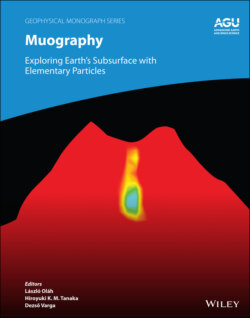Читать книгу Muography - Группа авторов - Страница 62
4.2 MUOGRAPHIC OBSERVATION OF THE SAKURAJIMA VOLCANO
ОглавлениеIn this section, we review how the muographic images are produced and prepared for ML‐based data processing. The MWPC‐based Muography Observation System operates with ten tracking systems in the SMO at a distance of approx. 2,800 m from the active craters of the Sakurajima volcano. Currently, all tracking systems are oriented towards the Showa crater at the same site to maximize the detection acceptance and thus the number of muons which are observed with a flux of 0.02 to 0.2 1/cm2/sr/day through the kilometer‐thick crater regions. Other chapters of this monograph describe the applied detector technology (Varga et al., 2021) as well as the experimental setup and data analysis methods (Oláh & Tanaka, 2021).
Fig. 4.1 shows the data flow diagram of MMOS. The data produced by MMOS are transferred to a remote server where automated track reconstruction and data quality assurance are performed based on a combinatorial algorithm (Oláh et al., 2018b). In the next step of data processing, the track count maps (muograms) are produced after the track selection, which is based on the goodness of track fits (χ2/ndf ). These muograms are sent to the database of the International Virtual Muography Institute, Global (Oláh et al., 2019a). For this study, the flux of penetrating particles were calculated for time periods of 24 hours (00:00:00 to 23:59:59). Fig. 4.2 shows three consecutive daily muograms that were captured by the MMOS with an angular bin size of Δθ x = Δθ y ≈ 23 mrad in both horizontal and vertical directions, corresponding to a spatial resolution of 60 meters. The black rectangles indicate the three crater regions that were selected for this study.
Figure 4.1 The data flow diagram of MWPC‐based Muography Observation System.
Figure 4.2 Three muograms captured by MWPC‐based Muography Observation System, corresponding to three consecutive days. The three black rectangles denote the angular regions of Minamidake (solid line), Showa crater (dashed line), and Surface (dotted line), respectively.
